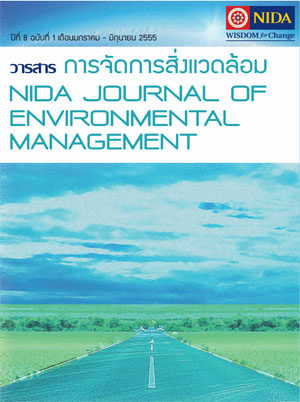อิทธิพลของสิ่งปกคลุมดินที่มีผลต่ออุณหภูมิในบรรยากาศของกรุงเทพมหานคร Impact of Land Cover on Atmospheric Temperature in Bangkok
บทคัดย่อ
การกำหนดสิ่งปกคลุมดินประเภทพื้นที่สีเขียวในปริมาณที่เหมาะสมเป็นแนวทาง หนึ่งในการจัดการสภาวะอากาศ ซึ่งสามารถลดสภาวะโดมแห่งความร้อนในเมืองได้ และนำไปส่การลดการใช้พลังงาน แม้ว่ามีงานวิจัยจำนวนมากที่แสดงถึงศักยภาพของพื้นที่สีเขียวในการลด อุณหภูมิ แต่ข้อมูลความรู้ส่วนใหญ่เป็นการนำเสนอข้อมูลในเชิงคุณภาพ ซึ่งการประยุกต์ใช้ข้อมูลดังกล่าวยังมีอุปสรรค เนื่องจากในการกำหนดการใช้ประโยชน์ที่ดินที่คำนึงถึงสภาวะอากาศจำเป็นต้อง ใช้ข้อมูลในเชิงปริมาณ ประกอบกับโครงสร้างเมืองแต่ละแห่งมีความแตกต่างกันในด้านทำเลที่ตั้ง สภาวะอากาศ และชนิดพืชพรรณ ซึ่งส่งผลถึงสัดส่วนของพื้นที่ธรรมชาติกับพื้นที่สิ่งปลูกสร้าง ในบทความนี้ประยุกต์ใช้ข้อมูลภาพถ่ายดาวเทียมเพื่อกำหนดชนิดและสัดส่วนสิ่ง ปกคลุมดนิ ที่เหมาะสมในเชิงปริมาณที่ทำให้สภาวะอากาศของกรุงเทพมหานครอยู่ในระดับสบาย ผลการศึกษาพบว่าสิ่งปกคลุมดินประเภทสิ่งปลูกสร้างมีความสัมพันธ์เชิงบวกกับ อุณหภูมิในขณะทีสิ่งปกคลุมดินประเภทต้นไม้และน้ำมีความสัมพันธ์เชิงลบกับ อุณหภูมิ โดยอุณหภูมิจะลดลง 0.028 องศาเซลเซียส หากเพิ่มพื้นที่ต้นไม้ทุกๆ ร้อยละ 1 บนพื้นที่ขนาด 0.1 ตารางกิโลเมตร ดังนั้นในการปรับสภาพภูมิอากาศของกรุงเทพมหานครให้อยู่ในระดับสบายจึงมีความ เป็นไปได้โดยการเปลี่ยนสัดส่วนสิ่งปกคลุมดินโดยเฉพาะการเพิ่มสัดส่วนพื้นที่ ต้นไม้และพื้นที่น้ำที่เหมาะสม
The existing urban climate and proper solutions to keep Bangkok’s atmosphere comfortable can be managed by means of land use/cover planning. Bangkok is located in a tropical zone; therefore, the heat island impact has placed more pressure on urban human comfort. Understanding the existing urban atmosphere and possible solutions is an important key to improving Bangkok’s atmosphere and to reducing energy consumption. Many researchers have found that green areas have a qualitative potential to reduce urban temperature. However, the qualitative potential of green areas is insufficient to identify exactly the amount of green areas that could reduce urban temperature. Furthermore, the urban structure of each city differs in location, climate, and vegetation, creating differences in the proportion of land use/cover. This study aims to quantify the proportion of land use/cover that would help the people of Bangkok become more comfortable. Apparent temperature and land cover data were derived from Landsat ETM+ acquired on 9 January 2008. Remote-based datasets were used to run multiple regression models providing a possible solution to reduce urban temperature by means of determining the proper proportion of land covers in urban areas. The study found that there was a correlation between the proportion of land cover types and apparent temperature. The results show a significant positive correlation between build-up area and temperature and a negative correlation between vegetation and water-covered land and temperature. The regression model demonstrates that every percent if increase of land covered by trees could result in a 0.028 degree Celcius decrease in temperature. The results of the regression model pave the way for the improvement of the urban atmosphere by increasing the vegetated canopy in urban areas.



